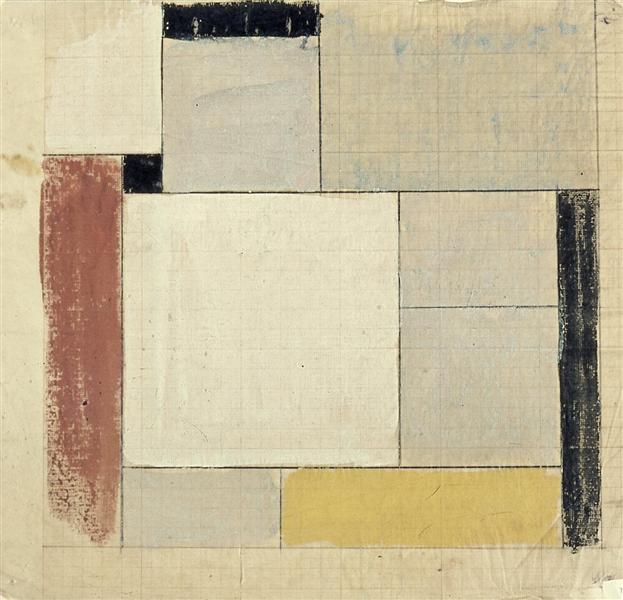Description
The painting "Draft of the soil" (1923) by Theo Van Doesburg is erected as an emblematic testimony of its innovative approach towards architecture and painting, immersed in the context of the STIJL movement. This work focuses on the creation of a space environment that reflects rational aesthetics and the search for harmony through geometry and primary colors, pillars in Van Doesburg's work and its contemporaries.
Visually, the work is characterized by a strictly geometric composition. The planning of its design suggests a radically new perspective of the interior space, where the plans are intertwined and the colors, arranged in an almost musical language, promote a sensation of balance. The alternation of rectangular and square forms resonates with the philosophy of De Stijl, which advocates an aesthetic order through abstraction. In "Draft of the soil", the disposition of these elements creates a visual rhythm that invites the viewer to perceive the space in a dynamic, almost architectural way.
The use of color in the work is equally significant. Van Doesburg applies a palette that highlights the primary colors: red, blue and yellow, in addition to including neutral tones, such as black, which delimit shapes and provide depth. This color choice not only seeks to impact visually, but also reflects the intention of the artist to unite art with everyday life, creating a space that transcends mere functionality. Vibrant colors work together to evoke sensations and emotions, suggesting an intrinsic relationship between shape and color that is fundamental in Stijl's principles.
It is important to highlight that "a draft of the soil" does not include characters or human figures, which emphasizes the artist's approach in the function and structure of space instead of focusing attention on the individual. This aspect aligns it with the ethos of the STIJL movement, which promoted a utopian vision of the art designated to serve society, and not to express personal subjectivity.
In this context, Van Doesburg's work can not only be considered a work of art, but also a contribution to modern architecture, a field in which he would be deeply involved. Its influence can be observed in the way in which the ideas of order, geometry and color have permeated contemporary architectural practice. When exploring the meaning of the work, Van Doesburg's intention is evidenced to challenge and redefine traditional space perceptions through a radically abstract approach.
The continuity of its aesthetics is also manifested in similar works of the time and its circle of influence, such as Piet Mondrian and Gerrit Rietveld's proposals, who, like Van Doesburg, explored the relationship between art and design, Painting and architecture, in addition to the integration of habitable spaces in a vision where art and life intertwine.
Thus, "the floor of the soil" of Theo Van Doesburg is presented not only as a masterpiece of design, but as a milestone that encapsulates the aspirations of an era that sought the creation of a new world, where art is a reflection of the social and functional harmony, a principle that continues to resonate in current artistic and architectural practice. In his ability to merge art with functional design, Van Doesburg manages to transcend his time, leaving us a legacy of innovation that invites a continuous reflection on the intersection of these fields.
KUADROS ©, a famous paint on your wall.
Hand-made oil painting reproductions, with the quality of professional artists and the distinctive seal of KUADROS ©.
Art reproduction service with satisfaction guarantee. If you are not completely satisfied with the replica of your painting, we refund your money 100%.

